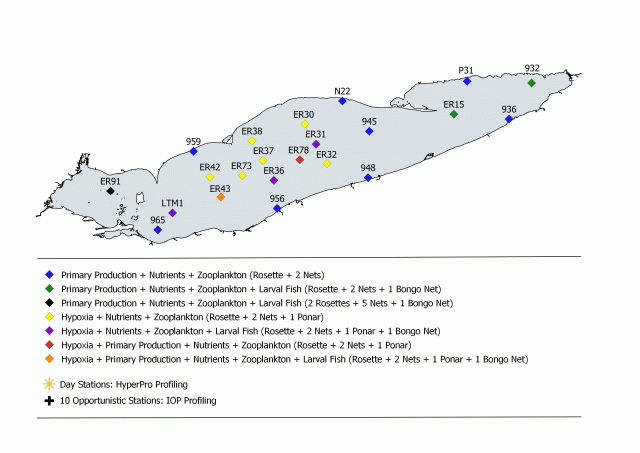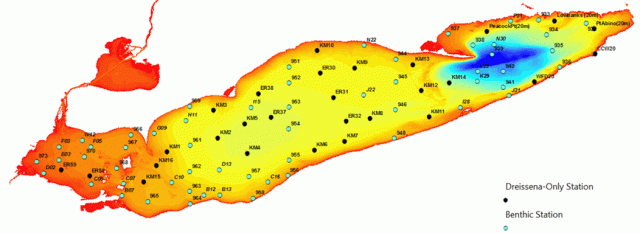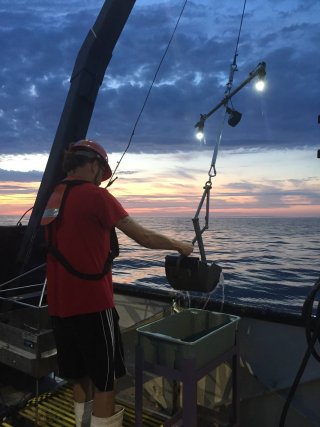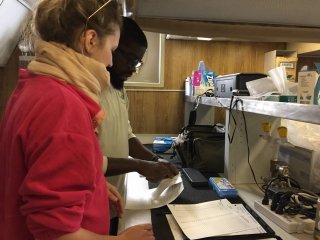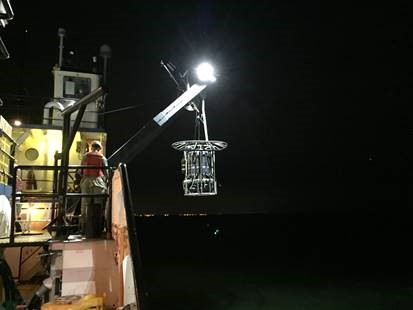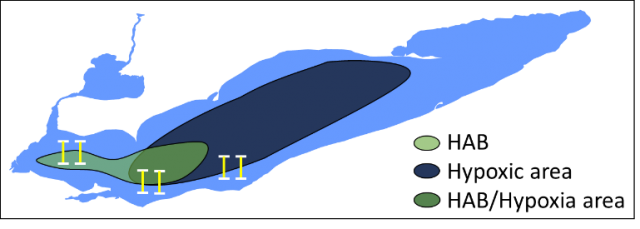2019 Surveys Conducted on Lake Guardian
In 2019, the R/V Lake Guardian supported five Lake Erie CSMI surveys. This page presents summaries of the science and participating partners:
On this page:
Lower Food Web Surveys
Two lower food web CSMI surveys were conducted on Lake Erie using the R/V Lake Guardian in May and September 2019. These surveys addressed the Lake Erie Partnership’s Changing Food Web and In-lake Eutrophication science priorities.
The scientific objective of these surveys was to determine how water quality, hypoxia, and the pelagic lower food web vary spatially and seasonally in Lake Erie. As Lake Erie is a highly variable ecosystem, intensive surveys are required to understand the mechanisms controlling harmful algal blooms (HABs), hypoxia, and the lower food web.
- water quality nutrients
- phytoplankton
- zooplankton
- larval fish
- sediment
Samples were also collected to perform the following laboratory experiments:
- primary productivity experiments
- zooplankton nutrient excretion experiments
- inherent optical properties
- apparent optical properties
Numerous partners were involved on these surveys, including:
- US EPA Great Lakes National Program Office
- US EPA Office of Research and Development Mid-Continent Ecology Division
- University of Michigan Cooperative Institute for Great Lakes Research
- Michigan Technological Research Institute
- The Ohio State University
- University of Toledo
- Cornell University
Benthos Survey
The teams conducting this research are made up of several GLRI partners:
- Environmental Protection Agency
- National Oceanic and Atmospheric Administration
- Buffalo State College
- Wright State University
- Cornell University
- Oak Ridge Institute for Science and Education
- Cooperative Institute for Great Lakes Research
Lower Food Web Contaminants Survey
Contaminants in the aquatic ecosystem can bioaccumulate through the food chain and potentially become present at higher concentrations in organisms at the top of the food chain. To better understand contaminant cycling in the Great Lakes open water food web, researchers from Clarkson University, EPA, USGS, NOAA GLERL, SUNY-Fredonia, and SUNY-Oswego assessed the biomagnification of legacy contaminants and chemicals of emerging concern in the lower food web in support of Lake Erie CSMI. Sampling was conducted at the Western Basin and Eastern Basin Great Lakes Fish Monitoring and Surveillance Program (GLFMSP) sites in Lake Erie in June 2019. This CSMI survey sampled water, sediment, phytoplankton, zooplankton, and benthos for contaminant analyses, thus targeting the major components of the Lake Erie lower food web.
Results from this survey supplement EPA’s long-term GLFMSP. Annual monitoring through the GLFMSP collects top predator fish from fixed sampling sites in each Great Lake. These fish are aged then analyzed for legacy and emerging contaminants in whole fish.
Harmful Algal Blooms/Hypoxia Survey
The scientific objective of the survey is to examine how harmful algal blooms (HABS) and bottom hypoxia (lack of oxygen) are driving change in the structure, function and dynamics of Lake Erie’s food webs. The factors will be considered both separately and combined.
This research will examine how the presence of HABs and hypoxia can affect the quantity and quality of prey available to the ecosystem’s top predators (walleye and yellow perch). It will help us understand how toxins produced by HABs, such as microcystin, are distributed throughout the water column, as well as within the food web.
HABs/hypoxia cruises were conducted July and August 2019 using the RV Lake Explorer II (operated by the U.S. EPA Office of Research and Development) and the CCGS Limnos (operated by Environment and Climate Change Canada and Department of Fisheries and Oceans, Canada).
- HABs
- hypoxic zones
- areas of combined HABs and hypoxia
Here are the questions this research is designed to answer:
- How does the composition of microbes, phytoplankton, zooplankton and fish differ among areas inside and outside of HABs, hypoxic zones and areas of combined HABs and hypoxia?
- How does the movement, behavior and distribution of higher consumers (zooplankton and fish) vary in the presence of one or both stressors? For example:
- Are these organisms “squeezed” between surface-dominated HABs and bottom hypoxia?
- Is diel vertical migration, or migration that happens between day and night, disrupted?
- Do higher consumers actively use HABs as a refuge from predation, or actively avoid them?)
- Do production and energy transfer between primary producers (microbes, algae), secondary consumers (zooplankton), and tertiary consumers (planktivorous fish) differ among areas?
- Does the quality of higher consumers decrease in the presence of one or both stressors?
- What role does food web transfer play in the accumulation of cyanotoxins (microcystin) in the edible tissue of fish?
- U.S. EPA
- Illinois-Indiana Sea Grant
- Ohio State University
- Department of Fisheries and Oceans, Canada

